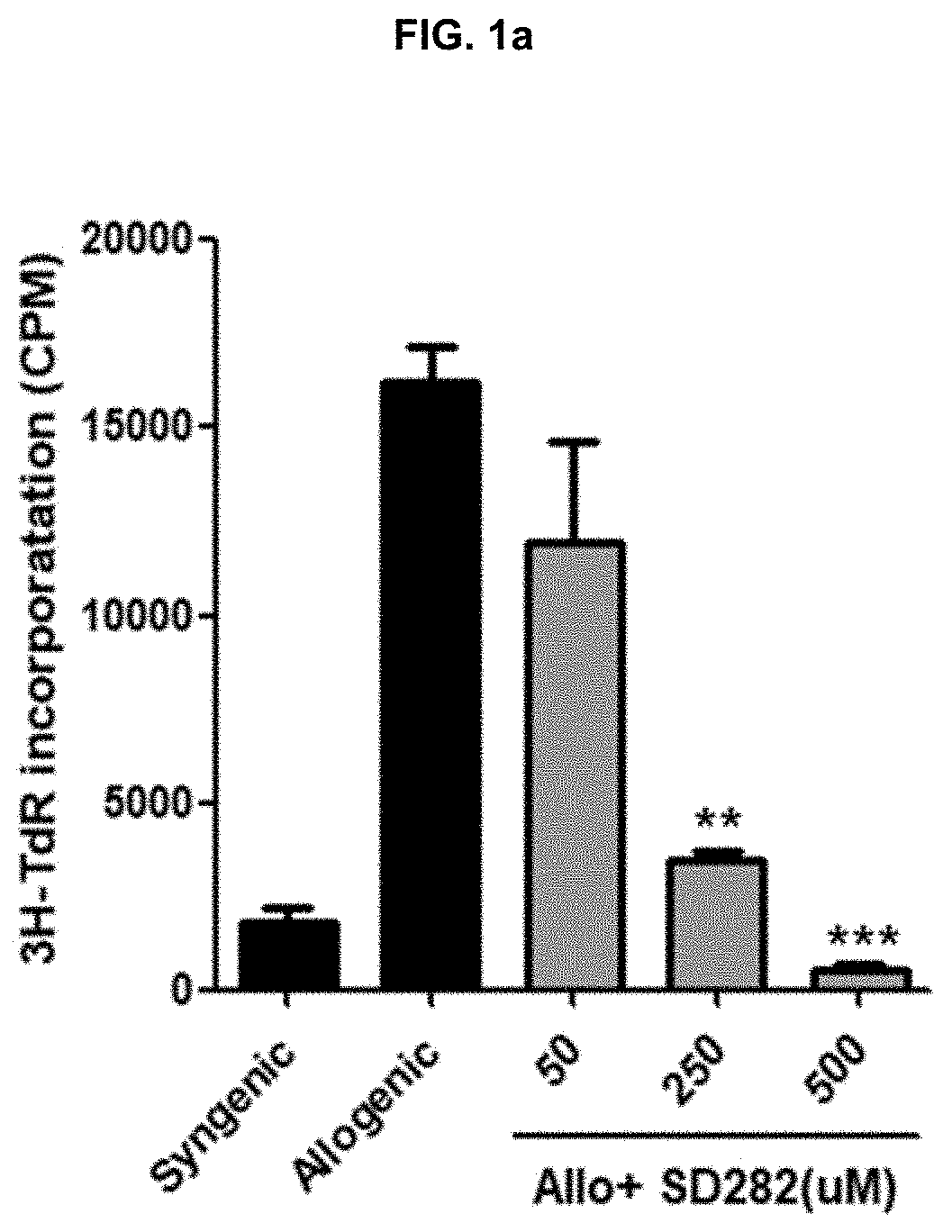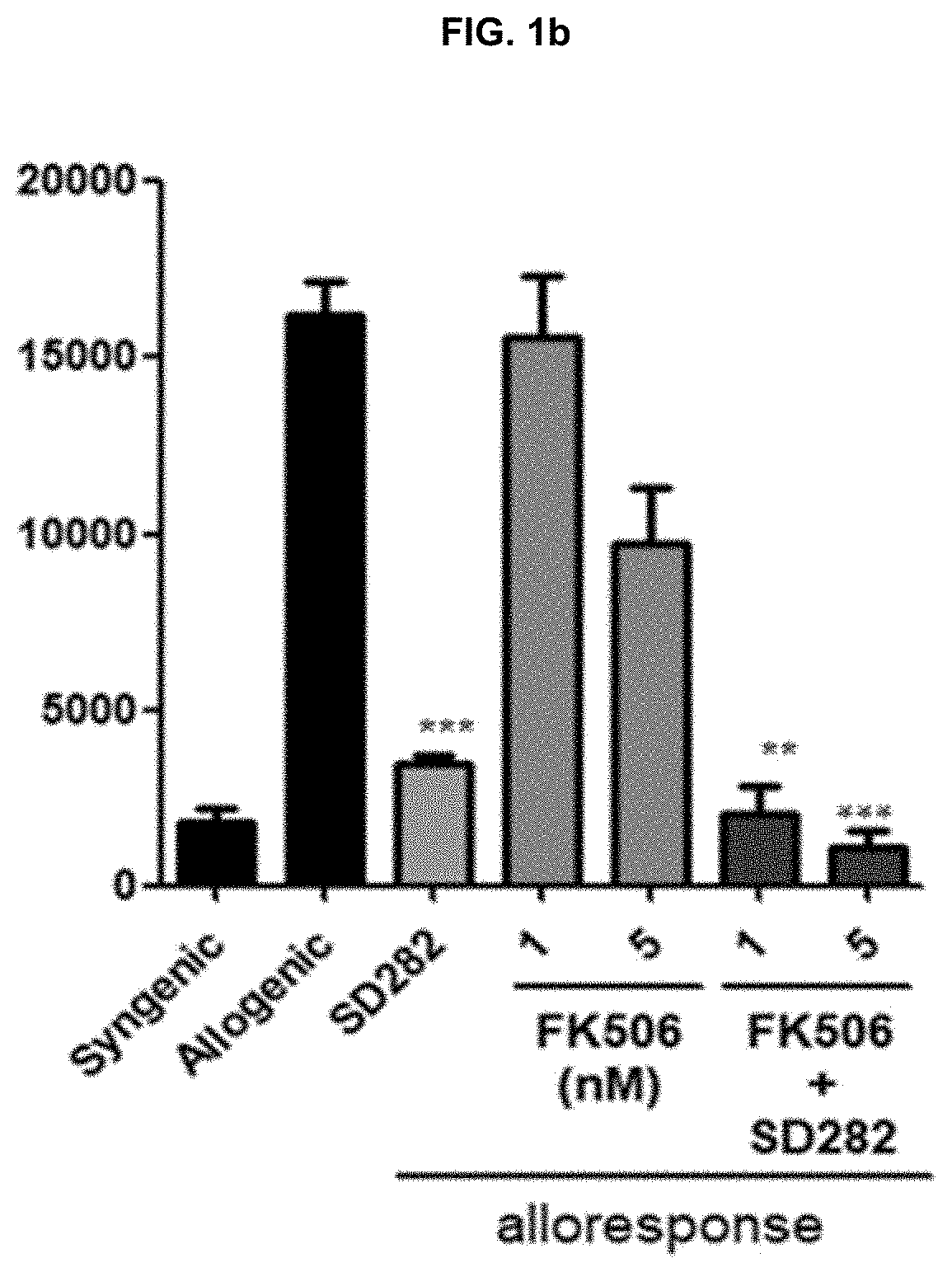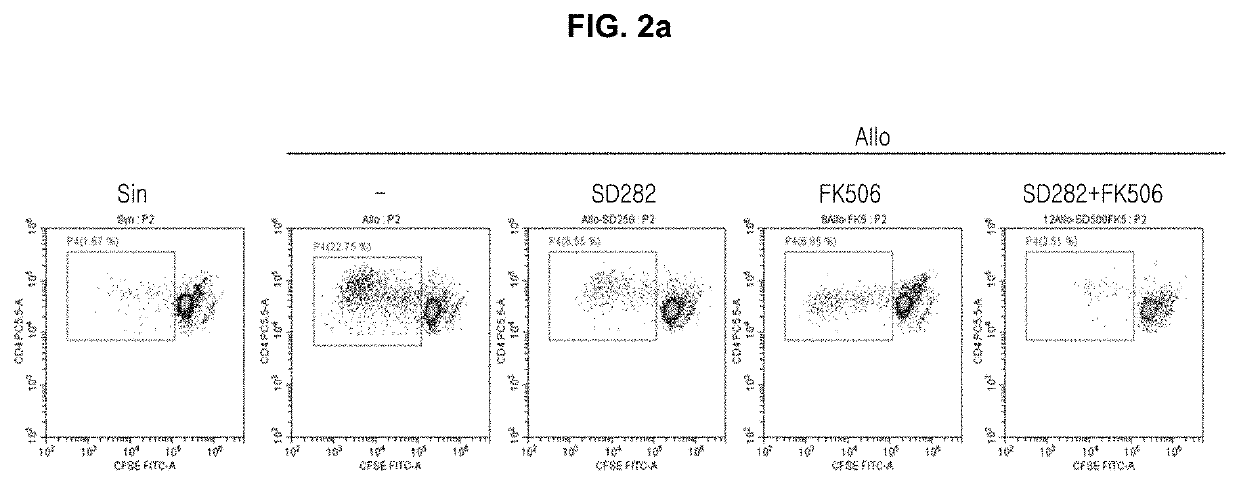Composition for preventing and treating transplant rejection or transplant rejection diseases, comprising novel compound and calcineurin inhibitor
a technology of calcineurin inhibitor and compound, which is applied in the direction of drug composition, organic active ingredients, immunosuppressant combination or therapy, etc., can solve the problems of inability to optimize the combination or therapy for co-administrating immunosuppressants, and the difficulty of maintaining long-term treatment effects, so as to reduce the activity of pathogenic th1 cells, inhibit side effects, and increase the activity of treg cells
- Summary
- Abstract
- Description
- Claims
- Application Information
AI Technical Summary
Benefits of technology
Problems solved by technology
Method used
Image
Examples
example 1
tal Method
[0069]1-1. In Vitro Syngeneic Graft Transplantation or Allogenic Transplantation Models
[0070]CD4+ T cells derived from a normal recipient (Balb / c, responder) (2×105 cells) were injected into each well of a 96-well round bottom plate, in vitro. Thereafter, for syngenic transplantation, normal recipient-derived T cell-removed splenocytes (2×105 cells), which had been irradiated with radiation, were added to each of the wells, followed by culturing under mixing. For allogenic transplantation, donor (C57BL / 6, stimulator)-derived T cell-removed splenocytes were added to each of the wells, followed by culturing under mixing.
[0071]1-2. Acute Graft Versus Host Disease (aGVHD) Animal Models
[0072]For preparing an aGVHD model, the recipient mouse Balb / c (H-2k / d) was subject to total body irradiation (TBI) in 800 cGy. Hematopoietic stem cells and splenocytes were isolated from the femur and tibia of the donor mouse C57BL / 6 (H-2k / b). The hematopoietic stem cells (5×106) and splenocytes...
example 2
n on T Cell Proliferations According to the Treatment of SD282 Alone, FK506 Alone or in Combination Thereof in Mouse Cells
[0075]In order to evaluate T cell proliferations according to the treatment with SD282 alone, FK506 alone or in combination thereof, the untreated syngenic group and the untreated allogenic group of Example 1-1 were used as controls. The allogenic model was treated with 50, 250 and 500 μM of SD282 alone or 1 and 5 nM of FK506 alone. And, FK506 (1 and 5 nM) and SD282 (250 μM) were treated in combination, respectively. After the treatments, each group was cultured for 4 days and then alloresponses were evaluated by observing the T cell proliferations of the cultured cells, according to the 3H-thymidine incorporation method, the CFSE assay method, or the flow cytometry method.
[0076]As shown in FIG. 1a, the T cell proliferation was not inhibited in the untreated allogenic group, but it was confirmed that the T cell proliferation was significantly inhibited when 250 μ...
example 3
n on the Activity of Th17 Cells or Treg Cells According the Treatment of SD282 and FK506 in Combination in Mouse Cells
[0080]3-1. Evaluation on Inhibitory Effects Against Pathogenic Th17 Cells
[0081]The T cell response regulates the activity of Th17 (T helper 17 cell) / IL-17 (Interleukin 17) and IL-17 is classified as an inflammatory cytokine. In Example 2, it was confirmed that T cells were effectively inhibited by the treatments with SD282 and FK506 alone or in combination. We also evaluated inhibitory activity against inflammatory cytokines according to the treatments with SD282 and FK506 alone or in combination. The untreated syngenic group and the untreated allogenic group of Example 1-1 were used as controls. The allogenic models were treated with 50, 250 and 500 μM of SD282 alone or 1 and 5 nM of FK506 alone. And, FK506 (1 and 5 nM) and SD282 (250 μM) were treated in combination, respectively. After the treatments, each group was cultured for 4 days and then stimulated with anti...
PUM
 Login to View More
Login to View More Abstract
Description
Claims
Application Information
 Login to View More
Login to View More - Generate Ideas
- Intellectual Property
- Life Sciences
- Materials
- Tech Scout
- Unparalleled Data Quality
- Higher Quality Content
- 60% Fewer Hallucinations
Browse by: Latest US Patents, China's latest patents, Technical Efficacy Thesaurus, Application Domain, Technology Topic, Popular Technical Reports.
© 2025 PatSnap. All rights reserved.Legal|Privacy policy|Modern Slavery Act Transparency Statement|Sitemap|About US| Contact US: help@patsnap.com



